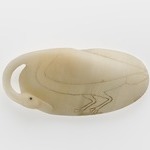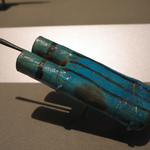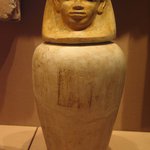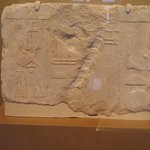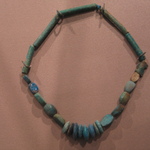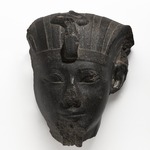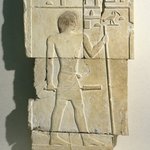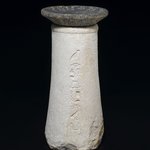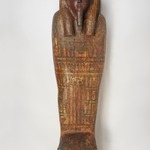

Head of a King, ca. 2650–2600 B.C.E. Granite, 22 × 12 × 13 in. (55.9 × 30.5 × 33 cm). Brooklyn Museum, Charles Edwin Wilbour Fund, 46.167. Creative Commons-BY (Photo: Brooklyn Museum, 46.167_front_PS22.jpg)
Head of a King
Egyptian, Classical, Ancient Near Eastern Art
Granite is extremely hard, but the sculptor of this statue was able to give the king’s plump face and small features a softly natural quality, perhaps suggesting the subject’s actual appearance rather than an idealized version. Originally, this fragment surmounted an oversize figure, achieving the same monumental quality as the pyramids being built at this time.
MEDIUM
Granite
DATES
ca. 2650–2600 B.C.E.
DYNASTY
late Dynasty 3 to early Dynasty 4
PERIOD
Old Kingdom
DIMENSIONS
22 × 12 × 13 in. (55.9 × 30.5 × 33 cm) (show scale)
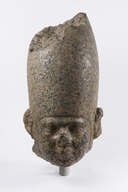


COLLECTIONS
Egyptian, Classical, Ancient Near Eastern Art
ACCESSION NUMBER
46.167
CREDIT LINE
Charles Edwin Wilbour Fund
PROVENANCE
Prior to 1921, provenance not yet documented; before 1921, acquired by Louis Herse of Alexandria, Egypt; 1921, purchased in Paris, France from Louis Herse by Theodore Pitcairn of Bryn Athyn, PA; October 10, 1946, purchased from Theodore Pitcairn by the Brummer Gallery, New York, NY; October 24, 1946, purchased from the Brummer Gallery (N6669) by the Brooklyn Museum.
Provenance FAQ
CATALOGUE DESCRIPTION
Colossal red granite head of a king in white crown. Broad features, eyes without paint stripes, no uraeus on crown, no beard. At the back of the neck a line indicating the top of a cloak which suggests that the head may be from a Heb-sed statue.
Condition: The tip of the crown is missing; also the end of the nose. Small chips from the right eye an upper lip; right ear weathered; minor weathering and chipping elsewhere on the surface but on the whole the preserved potion is in good condition. The break at the neck is irregular.
EXHIBITIONS
MUSEUM LOCATION
This item is not on view
CAPTION
Head of a King, ca. 2650–2600 B.C.E. Granite, 22 × 12 × 13 in. (55.9 × 30.5 × 33 cm). Brooklyn Museum, Charles Edwin Wilbour Fund, 46.167. Creative Commons-BY (Photo: Brooklyn Museum, 46.167_front_PS22.jpg)
IMAGE
front, 46.167_front_PS22.jpg. Brooklyn Museum photograph, 2024
"CUR" at the beginning of an image file name means that the image was created by a curatorial staff member. These study images may be digital point-and-shoot photographs, when we don\'t yet have high-quality studio photography, or they may be scans of older negatives, slides, or photographic prints, providing historical documentation of the object.
RIGHTS STATEMENT
Creative Commons-BY
You may download and use Brooklyn Museum images of this three-dimensional work in accordance with a Creative Commons license. Fair use, as understood under the United States Copyright Act, may also apply.
Please include caption information from this page and credit the Brooklyn Museum. If you need a high resolution file, please fill out our online application form (charges apply).
For further information about copyright, we recommend resources at the United States Library of Congress, Cornell University, Copyright and Cultural Institutions: Guidelines for U.S. Libraries, Archives, and Museums, and Copyright Watch.
For more information about the Museum's rights project, including how rights types are assigned, please see our blog posts on copyright.
If you have any information regarding this work and rights to it, please contact copyright@brooklynmuseum.org.
RECORD COMPLETENESS
Not every record you will find here is complete. More information is available for some works than for others, and some entries have been updated more recently. Records are frequently reviewed and revised, and we welcome any additional information you might have.











